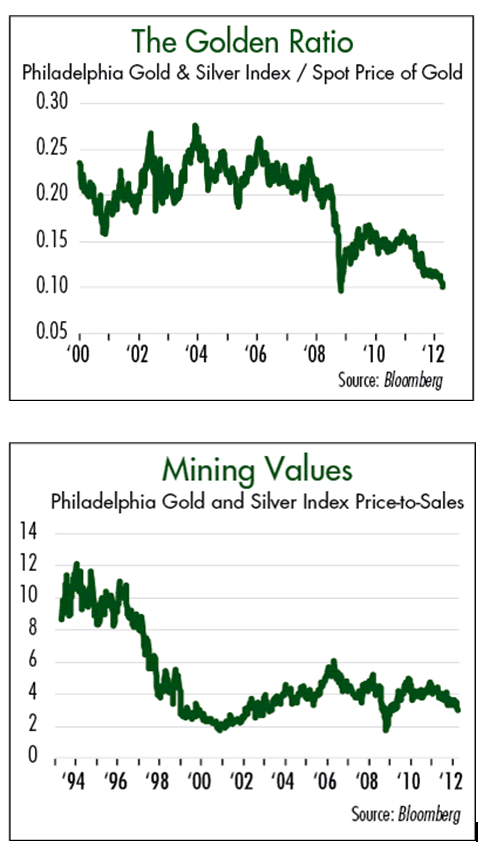Gold Is Money
Commodities / Gold and Silver 2012 May 10, 2012 - 01:51 AM GMTBy: Elliot_H_Gue

 For centuries, the yellow metal has been viewed as a store of wealth. Unlike dollars, euros or yen, gold can’t be printed or created out of thin air.
For centuries, the yellow metal has been viewed as a store of wealth. Unlike dollars, euros or yen, gold can’t be printed or created out of thin air.
Gold is a proven hedge against inflation; it’s also a hedge against crises. During the Great Recession of 2008-09, the worst economic downturn since the 1930s, gold prices rallied from $840 per ounce at the end of 2007 to over $1,200 by the end of 2009, even though inflation over this period remained subdued.
A sharp correction in gold prices in late 2011 was partly driven by financial institutions selling their gold to raise cash. However, the European Central Bank’s long-term refinancing operation—low-cost, three-year loans to European banks—eased financial institutions’ need to sell gold.
Uncertainty surrounding the upcoming US presidential election, fading seasonal tailwinds and a still-evolving EU debt crisis will limit US economic growth. There’s a strong chance the Federal Reserve will announce a third round of quantitative easing in the second half of 2012; the past two rounds of Fed money printing have proved bullish for gold.
All investors should hold at least a portion of their assets in gold, either in physical gold or the SPDR Gold Trust Shares (NYSE: GLD) exchange-traded fund.

Investors also shouldn’t ignore gold mining stocks. The Philadelphia Gold & Silver Index, which tracks the performance of large-capitalization gold mining names, trades near an all-time low relative to the price of gold bullion. (See “The Golden Ratio.”) In addition, mining stocks fetch an average of less than three times sales, a discount to their long-term average of five times. (See “Mining Values.”) This is an excellent time to accumulate positions in gold mining firms with the potential to grow their output over the next few years.
Freeport-McMoRan Copper & Gold (NYSE: FCX) is that rare mining stock which pays a generous and rising dividend. Most encouraging, the 25 percent increase in the May 1 payment—as with the 66 percent boost the year before and the 100 percent hike the year before—reflect the company’s relentless and successful expansion as much as a robust price environment.
First-quarter output of gold, copper and molybdenum—a key element for high-test steel—was somewhat lower than a year ago. This shortfall stemmed from the temporary suspension of operations at the Grasberg mine in Indonesia, which cut copper production by approximately 80 million pounds and gold by 125,000 ounces.
Without this disruption, the company’s metal production would have held steady with year-ago levels. The company is still on target to boost annual copper production by 25 percent over the next three to four years and boasts one of the most efficient cost structures among its peers.
Successful mine development prompted management to lift the first-quarter dividend by 25 percent, despite near-term softening in the market for its primary products. The company’s realized selling price for the red metal during the quarter was $3.82, roughly 11 percent below last year’s take. Realized prices for molybdenum were 15 percent lower. Gold prices surged 28 percent from year-ago levels, though the price of this precious metal has retreated from the $1,694 per ounce it fetched during the first quarter.
Looking ahead to the rest of 2012, the company expects production costs to rise as it pushes ahead with new development and restores output from its Grasberg mine to normal levels. That’s induced management to reduce its cash flow forecast to $4.2 billion, while increasing expected capital spending to $4.3 billion for the year.
Increasing costs, coupled with investor uncertainty about China’s economy, have pushed Freeport shares down to a new trading range in the upper 30s, from a level in the upper 40s earlier this year and a high of nearly 60 in late 2010.
These price fluctuations are normal for a company that produces natural resources. However, investors have the opportunity to buy the world’s fastest-growing major resource company with diminishing political risk and a strong balance sheet at its lowest price since the 2008-09 recession.
The stock provides income, growth and a potential hedge against inflation.
Mr. Gue is also editor of The Energy Strategist, helping subscribers profit from oil and gas as well as leading-edge technologies like LNG, CNG, natural gas liquids and uranium stocks.
He has worked and lived in Europe for five years, where he completed a Master’s degree in Finance from the University of London, the highest-rated program in that field in the U.K. He also received his Bachelor’s of Science in Economics and Management degree from the University of London, graduating among the top 3 percent of his class. Mr. Gue was the first American student to ever complete a full degree at that business school.
© 2012 Copyright Elliott H. Gue - All Rights Reserved
Disclaimer: The above is a matter of opinion provided for general information purposes only and is not intended as investment advice. Information and analysis above are derived from sources and utilising methods believed to be reliable, but we cannot accept responsibility for any losses you may incur as a result of this analysis. Individuals should consult with their personal financial advisors.
Elliott H. Gue Archive |
© 2005-2022 http://www.MarketOracle.co.uk - The Market Oracle is a FREE Daily Financial Markets Analysis & Forecasting online publication.


